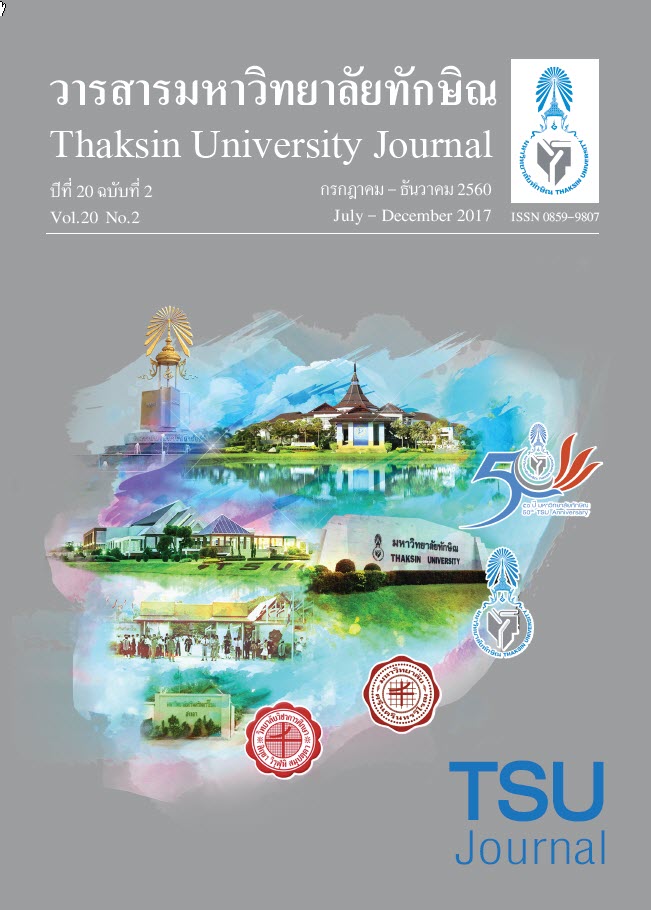Study of Chemical Constituents from Palm Fruit (Elaeis guineensis)After Harvesting and the Application of Palm Lipase for Biodiesel Production
Main Article Content
Abstract
Palm fruit after 0 h of harvesting was collected and extracted. Extraction with methanol gave the highest
yield with the value of recovery yield at 21.64%. High saponin, phenol and tannin were also detected. The chemical composition of palm fruit after 0-240 h of harvesting was characterized. The results showed that phenolic, vitamin E, protein and carotene decreased as harvesting time increased. In contrast, enzyme activity in lipase increased as harvesting time increased. The highest lipase activity was achieved at 120 h of harvesting and the activity increased to 4.76 U/mg after partial purification. Therefore, palm lipase was used as the catalyst for biodiesel production using waste cooking oil as substrate. Purified enzyme reached the optimal reaction time for biodiesel production after 6 h. A similar result was also obtained from commercial lipase. A longer incubation time (12 h) was observed in crude enzyme. Highest methyl ester content (96.5-98%) was achieved in this study and biodiesel specifications were characterized and passed Thailand’s fuel and American Society for Testing and Materials (ASTM) standards.
Article Details
References
composition, morphological characteristics, and cell wall structure of Malaysian oil palm fibers”,
Polymer-Plastics Technology and Engineering. 47, 273-280.
[2] Kok, S., Ong-Abdullah, M., Ee, G.C. and Namasiyayam, P. (2011). “Comparison of nutrient composition in
kernel of tenera and clonal materials of oil palm (Elaeis guineensis Jacq.)”, Food Chemistry. 129, 1343-1347.
[3] Edem, D.O. (2002). “Palm oil: biochemical, physiological, nutritional, hematological and toxicological aspects:
a review”, Plant Foods for Human Nutrition. 57, 319-341.
[4] Ahmad, A.L., Chan, C.Y., Abd Shukor, S.R. and Mashitah, M.D. (2008). “Recovery of oil and carotenes from
palm oil mill effluent (POME)”, Chemical Engineering Journal. 141, 383-386.
[5] Rhein, M. (2014). Industrial Oil Palm Development : Liberia’s Path to Sustained Economic Development
and Shared Prosperity Lessons from the East. Washington, DC: Rights and Resources Initiative.
[6] Yin, N.S., Abdullah, S. and Phin, C.K. (2013). “Phytochemical constituents from leaves of Elaeis guineensis
and their antioxidant and antimicrobial activities”, International Journal of Pharmacy and
Pharmaceutical Science. 5, 137-140.
[7] Konate, K., Souza, A., Therese, K.Y., Dibala, I.C., Barro, N., Millogo, R.J. and Nacoulma, O.G. (2011).
“Phytochemical composition, antioxidant and anti-inflammatory potential of bioactive fractions from
extracts of three medicinal plants traditionally used to treat liver diseases in Burkina Faso”, International
Journal of Phytomedicine. 3, 406-415.
[8] Razavi, S.M.A. and Taghizadeh, M. (2007). “The specific heat of pistachio nuts as affected by moisture content,
temperature and variety”, Journal of Food Engineering. 79, 158–167.
[9] Teixeira, C.B., Macedo, G.A., Macedo, J.A., Da Silva, L.H.M., Da, C. and Rodrigues, A.M. (2013).
“Simultaneous extraction of oil and antioxidant compounds from oil palm fruit (Elaeis guineensis) by
an aqueous enzymatic process”, Bioresource Technology. 129, 575-581.
[10] AOAC. (1990). Official Methods of the Association of Official Analytical Chemists (14th ed). Washington, DC.
[11] Schieber, A., Marx, M. and Carle, R. (2002). “Simultaneous determination of carotenes and tocopherols in
ATBC drinks by high-performance liquid chromatography”, Food Chemistry. 76, 357-362.
[12] Kimtun, P., Choonut, O., Yunu, T., Paichid, N., Klomklao, S. and Sangkharak, K. (2015). “Biodiesel production
using lipase from oil palm fruit as a catalyst”, Energy Procedia. 79, 822-826.
[13] Bouhlali, Ed.T., Alem, C., Ennassir, J., Benlyas, M., Mbark, A.N. and Zegzouti, Y.F. (2015). “Phytochemical
compositions and antioxidant capacity of three date (Phoenix dactylifera L.) seeds varieties grown in
the South East Morocco”, Journal of the Saudi Society of Agricultural Science. In pressed, available
online 11 November 2015, from http://dx.doi.org/10.1016/j.jssas.2015.11.002.
[14] Chen, Y., Xiao, B., Chang, J., Fu, Y., Lv, P. and Wang, X. (2009). “Synthesis of biodiesel from waste cooking
oil using immobilized lipase in fixed bed reactor”, Energy Conversion and Management. 50(3), 668-673.
[15] Eloff, J.N. (1998). “Which extractant should be used for the screening and isolation of antimicrobial components
from plant?”, Journal of Enthnophamacology. 60(1), 1-8.
[16] Atchley, A.A. (1984). “Nutritional value of palms”, Principles. 28, 138-143.
[17] Dai, J. and Mumper, R.J. (2010). “Plant phenolics: extraction, analysis and their antioxidant and anticancer
properties”, Molecules. 15, 7313–7352.
[18] Amira, E.A., Behija, S.E., Beligh, M., Lamia, L., Manel, I., Mohamed, H. and Lotfi, A. (2012). “Effect of
the ripening stage on phenolic profile, phytochemical composition and antioxidant activity of date palm
fruit”, Journal of Agricultural and Food Chemistry. 60, 10896-10902.
[19] Ong, H.C. (2004). Tumuhan liar. Khasiat Ubatan Dan Kegunaan Lain. Utusan Publication and Distributor,
Kuala Lumpur.
[20] Neo, Y.P., Ariffin, A. and Tan, C.P. (2010). “Phenolic acid analysis and antioxidant activity assessment of
oil palm (E. guineensis) fruit extract”, Food Chemistry. 122, 353-359.
[21] Bruice, T.C. and Benkovic, S.J. (2000). “Chemical basis for enzyme catalysis”, Biochemistry. 39, 6267-6274.
[22] Ajayi, O.E., Awala, S.I., Ogunleye, A.G. and Okogbue, F.N. (2016). “Antimicrobial screening and
phytochemical analysis of Elaeis guineensis (Ewe Igi Ope) against Salmonella strains”, British Journal
of Pharmaceutical Research. 10(3), 1-9.

